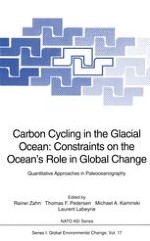1994 | OriginalPaper | Chapter
Late Quaternary Paleoproductivity Variations in the NE and Equatorial Atlantic: Diatom and Corg Evidence
Authors : Fatima Abrantes, Kyaw Winn, Michael Sarnthein
Published in: Carbon Cycling in the Glacial Ocean: Constraints on the Ocean’s Role in Global Change
Publisher: Springer Berlin Heidelberg
Included in: Professional Book Archive
Activate our intelligent search to find suitable subject content or patents.
Select sections of text to find matching patents with Artificial Intelligence. powered by
Select sections of text to find additional relevant content using AI-assisted search. powered by
We have generated 350 ka records of diatom accumulation rates (DAR) and export production (Pexp.), based on organic carbon accumulation rates, for Core 16772 in the eastern Equatorial Atlantic (EEA). These records were compared to published records for the coastal upwelling areas off Portugal and NW Africa, in order to obtain a better understanding of NE Atlantic paleoproductivity variations.Accumulation rates of the various siliceous microfossils correlate well at each location. The DAR shows a good overall correspondence to Pexp. at all locations; however, discrepancies between the DAR and Pexp. records at the beginning of the interglacial stages are noted for all areas. Assuming that both records are basically a measure of the same process, the primary productivity in the surface ocean, the observed discrepancies can be explained by changes in opal preservation and/or in the plankton community that dominated the equatorial waters during this time. The EEA records exhibit marked oscillations, with maxima occurring during glacial stages. This oscillating character is interpreted as deriving from variations in productivity through time, so that increased primary production has characterized every major glacial period for the last 350 ka in the area. However, only glacial Stages 6 and 4 are characterized by high abundance spikes of the large diatom Ethmodiscus rex (Rattray) Hendey.Comparison of this equatorial upwelling record with the record of the coastal upwelling areas (1326 KS11 off Portugal and 12392–1 off NW Africa) for the last 120 ka, shows that although the maxima are of the same order of magnitude, the times of maximum values are not the same. In the eastern Equatorial Atlantic the most intense DAR and Pexp. peaks are observed during Stage 4 but barely recorded in the coastal areas where the most productive period is Stage 2. This high productivity recorded during Stage 2 on coastal areas is also recorded in the EEA by a Pexp. maximum of the same magnitude, although DAR values are 4xs lower than the observed in the coastal record. The difference in the timing of maximum siliceous production (DAR) between oceanic and coastal regimes which is not observed for the carbon production record (Pexp.), is interpreted as an indication of important changes in the silica concentration of the upwelling source waters (intermediate waters).
